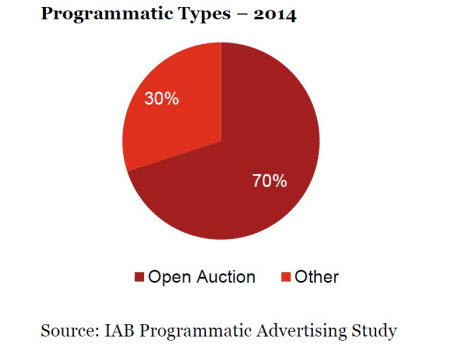Programmatic Video Ads on the Rise

Programmatic advertising may be the future, but the extension of automated processes to the premium digital video world, including video delivered over the top, continues to lag well behind the digital display advertising industry.
That’s the consensus from a fresh PricewaterhouseCoopers study on the topic, sponsored by the Interactive Advertising Bureau.
The study, which based its findings on a mix of survey results, corporate and industry data and interviews with senior ad executives, found that programmatic revenues reached $10.1 billion in 2014, and comprised about 20% of total Internet advertising revenues ($49.5 billion), a figure that factored in mobile-related advertising.
Programmatic revenues made up about 52% of display ads ($19.6 billion) last year, outpacing nonprogrammatic display-related revenues. The majority (70%) of programmatic inventory was bought and sold through “Open Auctions,” though PwC expects other types of approaches, including private auctions, unreserved fixed rate and automated guaranteed, to absorb more share in the next few years.
Broken down further, programmatic revenues from ad tech companies (55%) outweighed those from the publishers themselves. Display banner ads made up about 80% of programmatic revenues in 2014, but more advertisers and publishers are expected to shift their budgets and inventory toward mobile and OTT/digital video formats over time.
Programmatic video advertising remains a small-but-growing sector as more viewing occurs on mobile and other IP-connected devices.
“[T]he adoption of programmatic video in 2014 was hindered partly due to the scarcity of available premium-video inventory,” PwC noted. “As eyeballs have shifted away from traditional TV viewing to newer forms of video consumption, including online and mobile devices, brands want to connect with their audiences at the right time and right place. For video that often means through premium publisher inventory, but it is often not available for advertisers via programmatic channels.”
Multichannel Newsletter
The smarter way to stay on top of the multichannel video marketplace. Sign up below.
However, what little premium video inventory there is tends to sell out through more traditional digital direct sales channels.
“As a result of this demand, premium video publishers are able to sell their inventory directly and can negotiate deals with advertisers at a premium price. Inventory that goes unsold (remnant) on premium video publishers, which is often less valuable, is then pushed to the programmatic channels,” PwC said.
The study also took a stab at the somewhat controversial definition of the programmatic term itself, centering it on “machine based buying and selling of digital media, including auction based methods like RTB [real- time bidding] and private marketplaces, as well as the automation of direct sales, sometimes called programmatic direct.”
